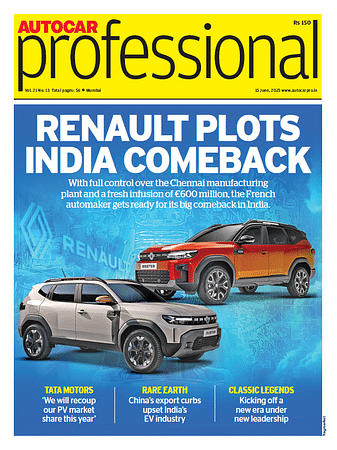EVs now contribute 20% to Bajaj Auto's domestic revenues: Rakesh Sharma
40% of Bajaj Auto's revenue comes from green fuels CNG and EVs, Executive Director Rajesh Sharma said.
Bajaj Auto’s electric vehicle (EV) journey is gaining significant traction, with EVs now accounting for 20% of the company’s domestic revenue. Executive Director Rakesh Sharma said that this milestone is a testament to the company’s strategic focus on electrification and innovation at the Chetak 35 series launch in Pune.
With its flagship Chetak electric scooter leading the charge, Bajaj Auto is rapidly transforming its revenue mix in the competitive two-wheeler market, positioning itself as a key player in India’s EV revolution, he added.
Sharma said that 40% of Bajaj Auto's revenue comes from green fuels-- CNG and EVs.
According to the VAHAN data for the first 20 days of December, Bajaj Auto led the EV two-wheeler market with 12,651 units sold, securing a 26.6% market share. TVS followed closely, selling 10,489 units with a 22% share, while Ola Electric recorded sales of 9,151 units, capturing 19.2% of the market.
According to Bajaj Auto, it was a slow, measured approach to get to the lion's share. "Our market share improvement is as a result of a measured strategy of carefully expanding and taking the feedback of our customers seriously. We need to be in a commanding leadership but we also need to look at both the top line and bottom line. We want to be no.1 but we want to maintain our best in class profitability," Rakesh Sharma, ED, Bajaj Auto said. "Chetak is now profitable."
Industry wide, while ICE scooter segment has grown by 19% between April and November, EVs have surged ahead, nearly doubling that rate with a remarkable 35% growth. "The customer has switched to the electric option. We would like to sustain the market share this is a marathon but building position takes time so we didn't want to be the first but we don't want to be on the last either because then it's difficult to catch up. We want to be in the middle and then move forward," Sharma said.
In recent months, long-time market leader Ola has expanded its portfolio with a range of affordable electric scooters priced between Rs 39,999 and Rs 64,999, alongside its Roster Motorcycles, catering to the Rs 75,000–2,50,000 segment. The company has set its sights on an aggressive growth trajectory, planning to launch over 20 new products in the next two years, with a target of introducing one new product every quarter.
Bajaj Auto, too, is on an expansion spree with plans to expand in both premium and affordable segments. "Will be expand in all segments and will also have something targetted to gig workers. Our current capacity of 40,000 can be expanded to 60,000 and we're also looking at export which will take at least 6 months from now," Sharma said.
RELATED ARTICLES
The Truck Whisperer Of Tata Motors: How Shubhranshu Singh Made It To The Forbes World’s Most Influential CMOs List For 2025
From AI-powered micro-campaigns to regional storytelling in 11 languages, Singh is changing the narrative around commerc...
Tata Motors Is ‘Structured to Thrive’ Amid Global Volatility, Says N Chandrasekaran
Despite global headwinds, Tata Motors aims to lead with agility, EV focus, and strategic independence across business li...
Royal Enfield-UNESCO Docuseries on Ladakh Heritage to Premiere on National Geographic
Four-part series documents intangible cultural heritage practices through rider-researcher expedition.





 By Prerna Lidhoo
By Prerna Lidhoo
 20 Dec 2024
20 Dec 2024
 7415 Views
7415 Views





 Autocar Professional Bureau
Autocar Professional Bureau


 Darshan Nakhwa
Darshan Nakhwa

 Shruti Shiraguppi
Shruti Shiraguppi

